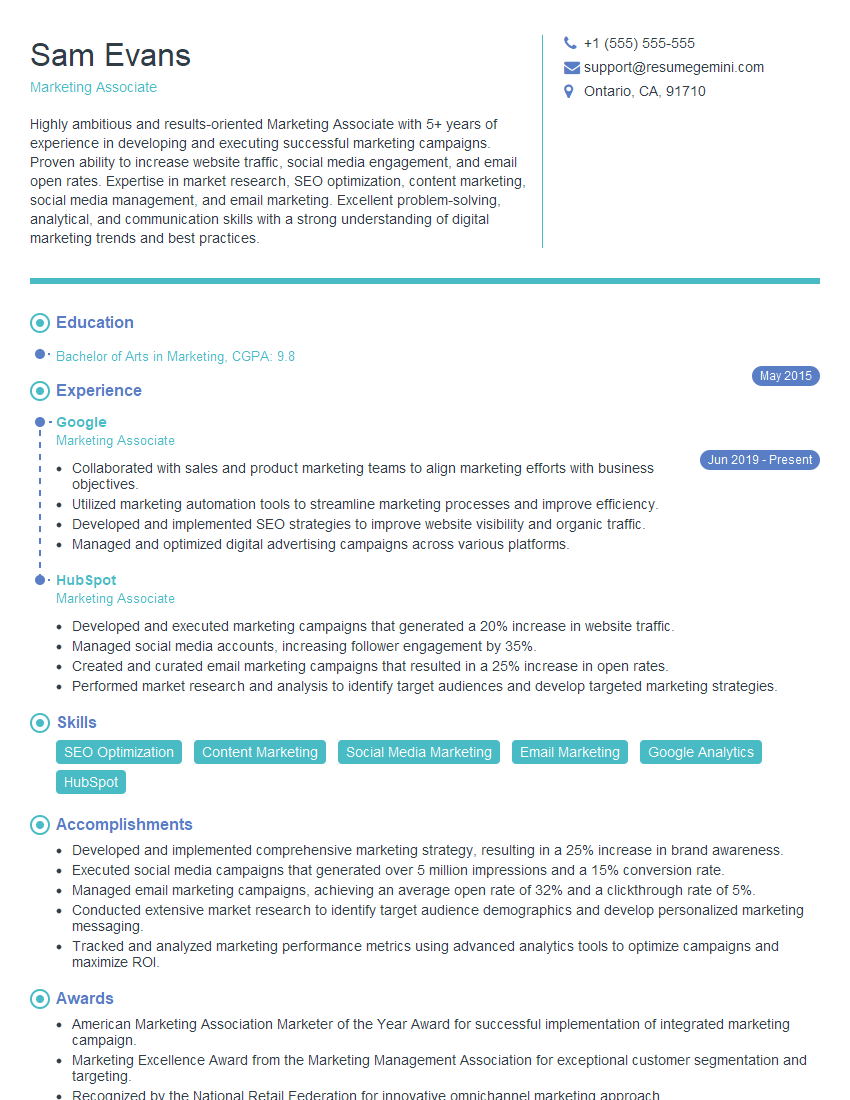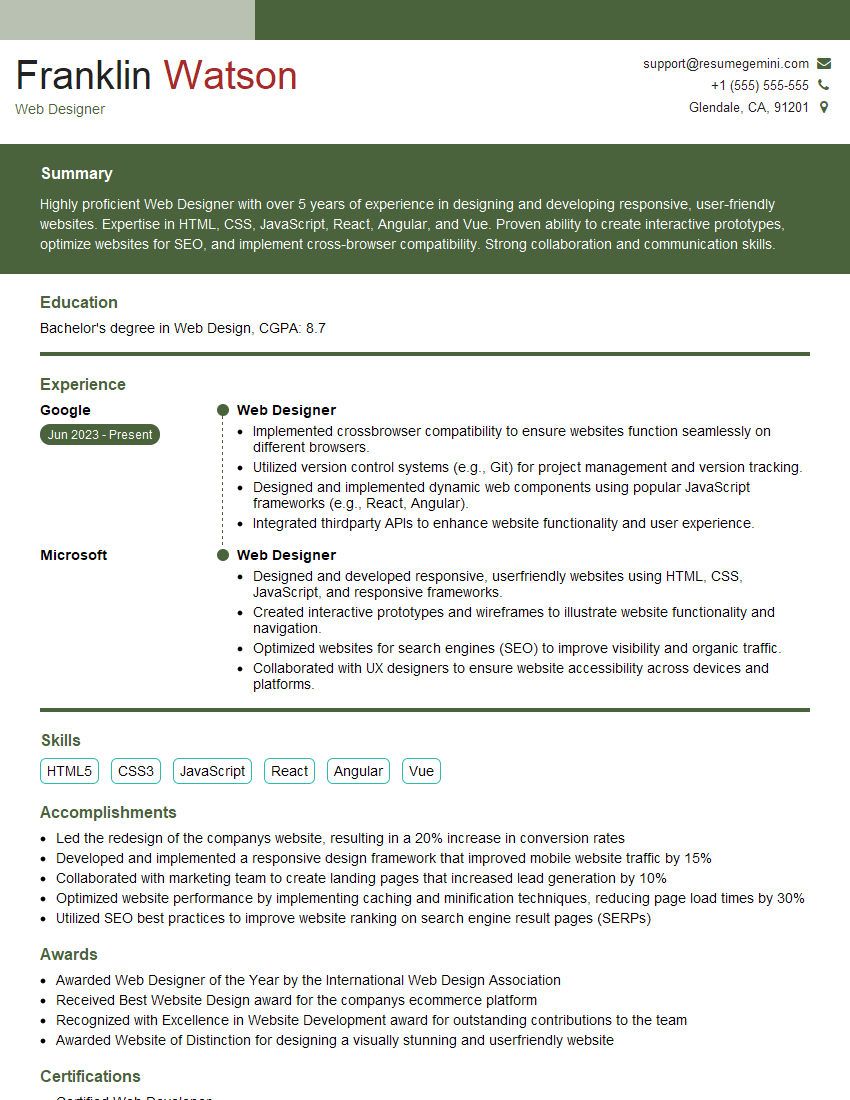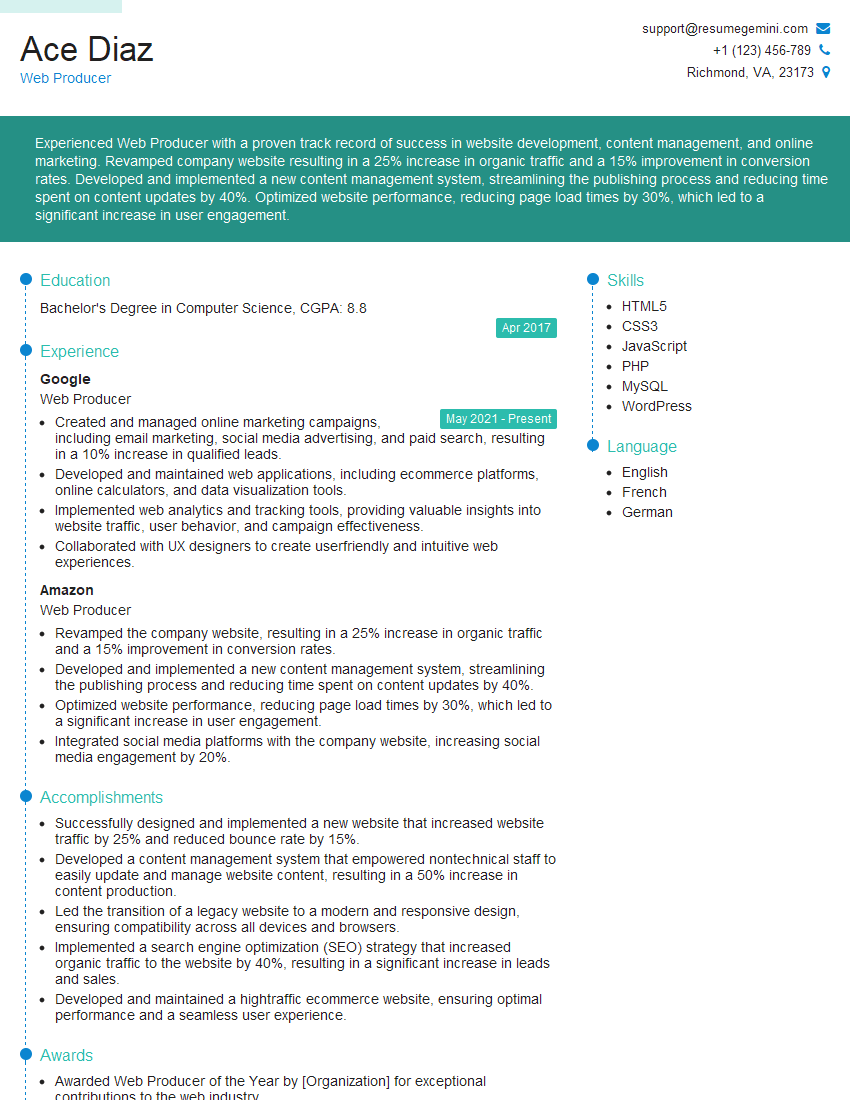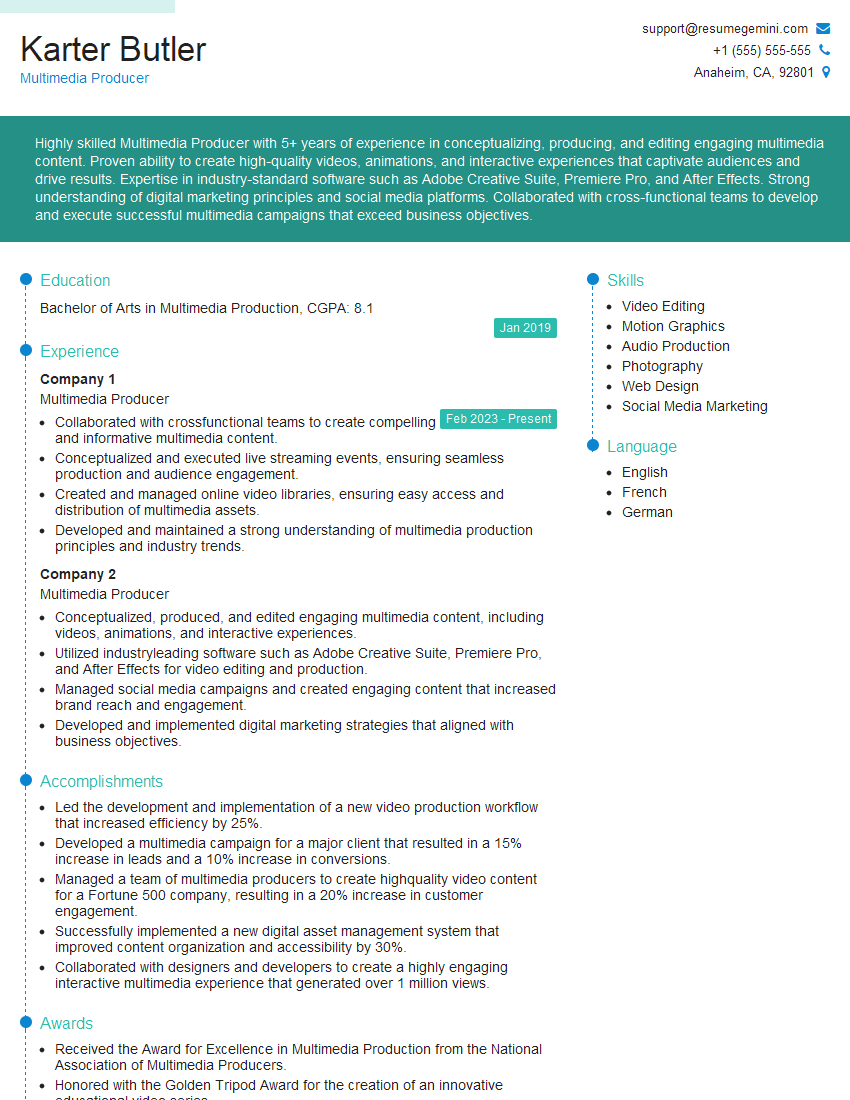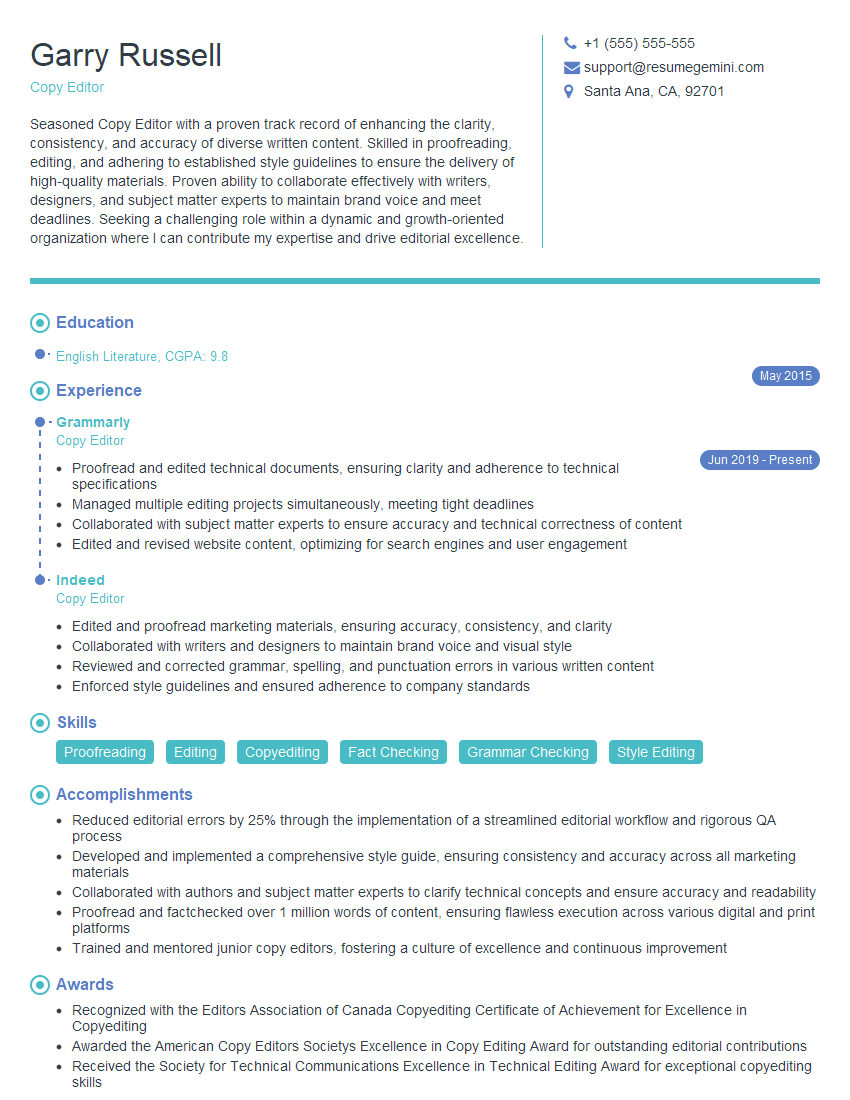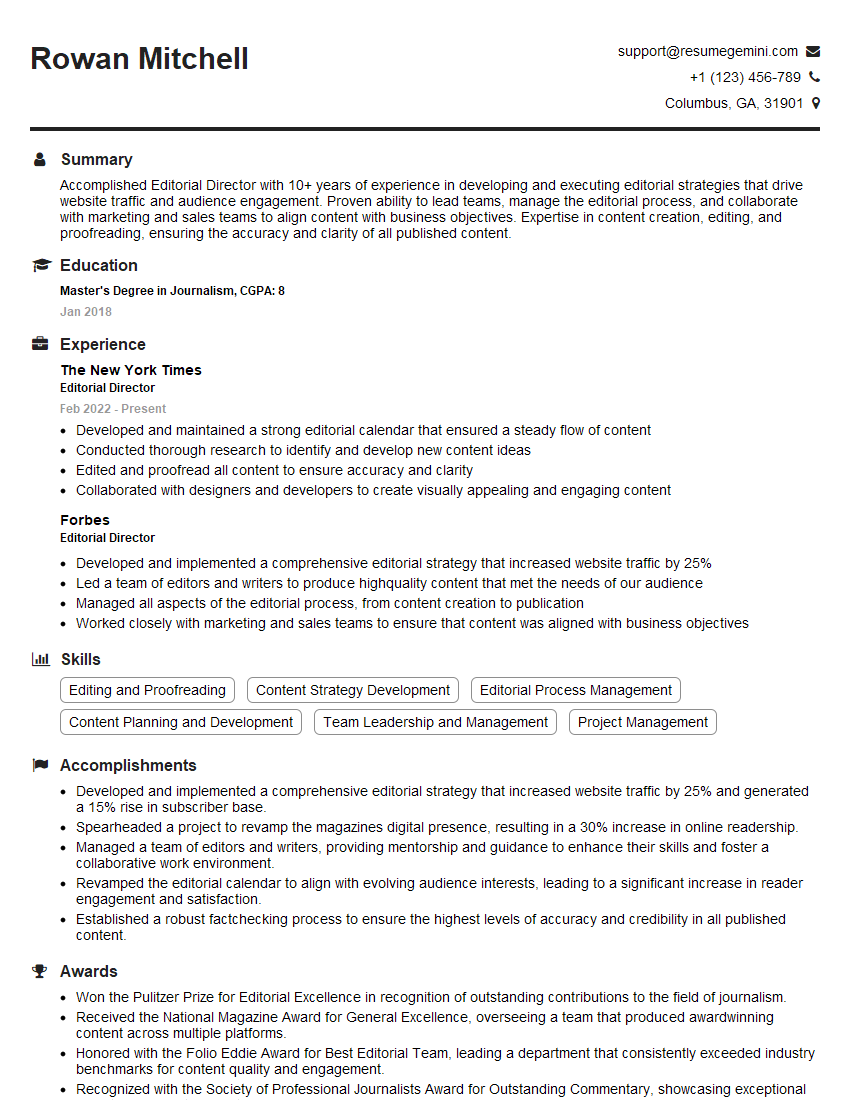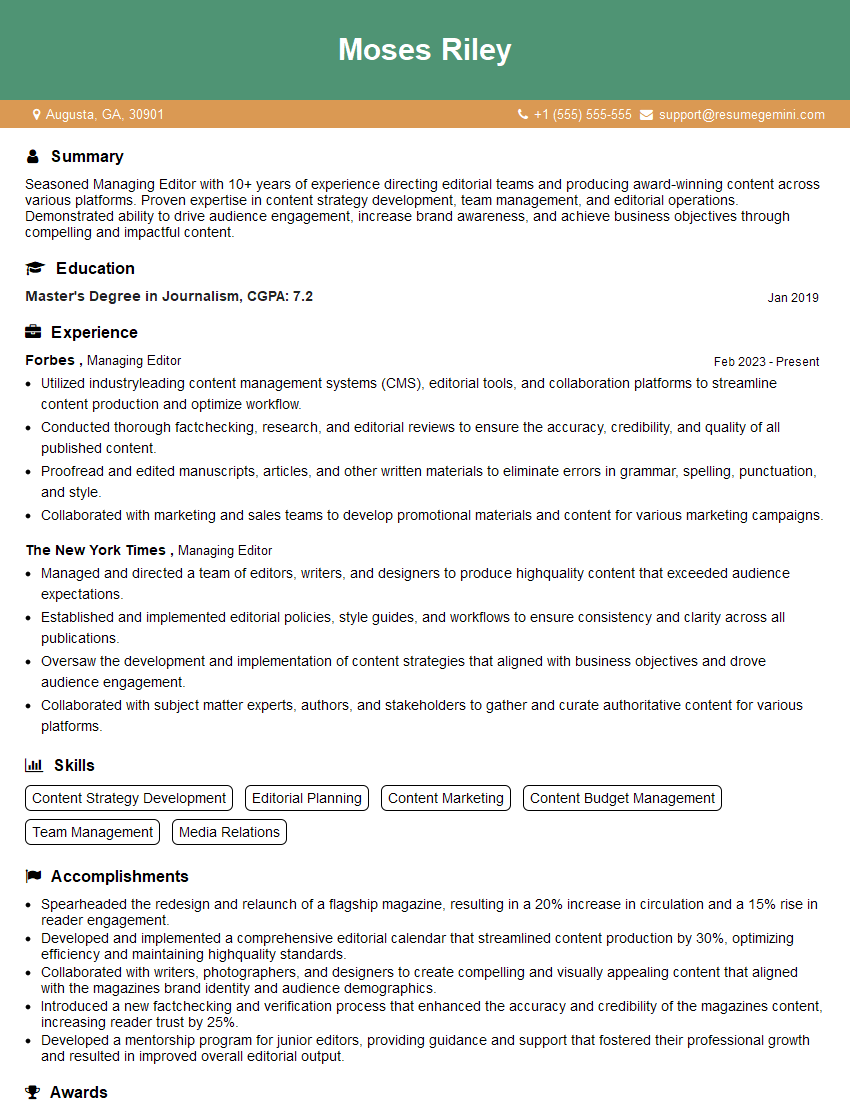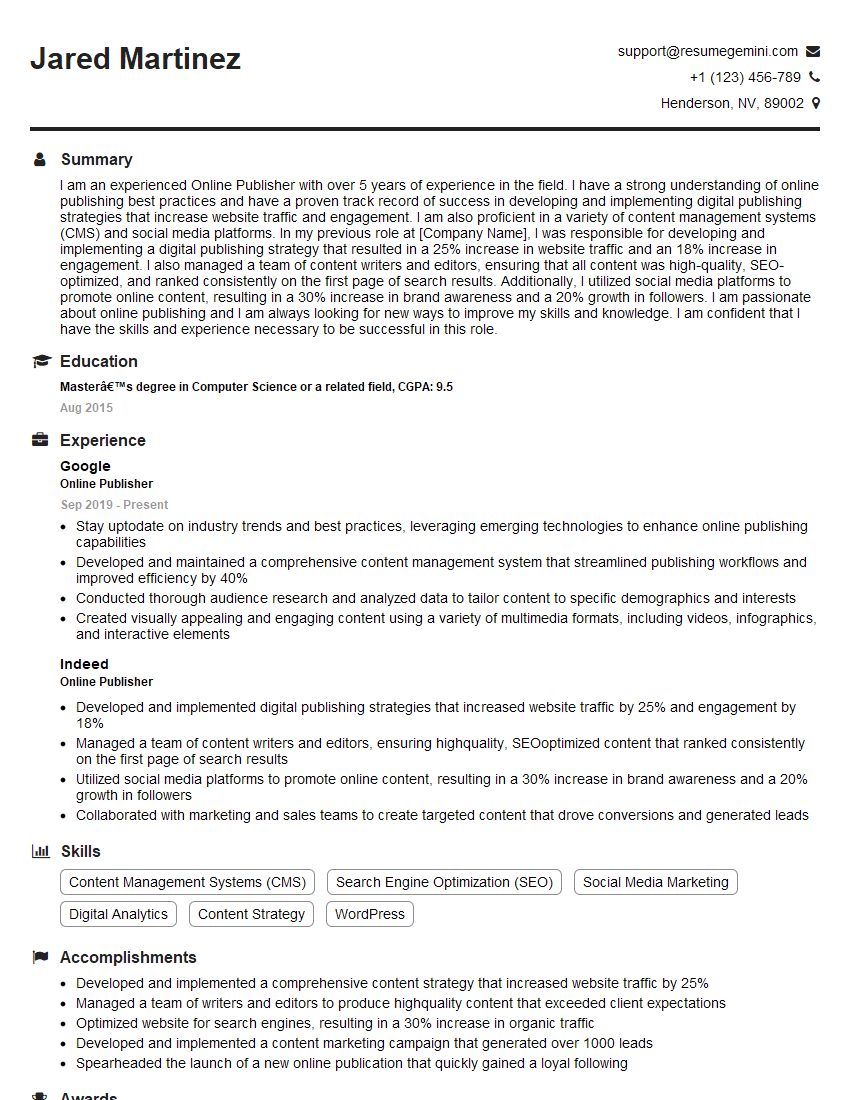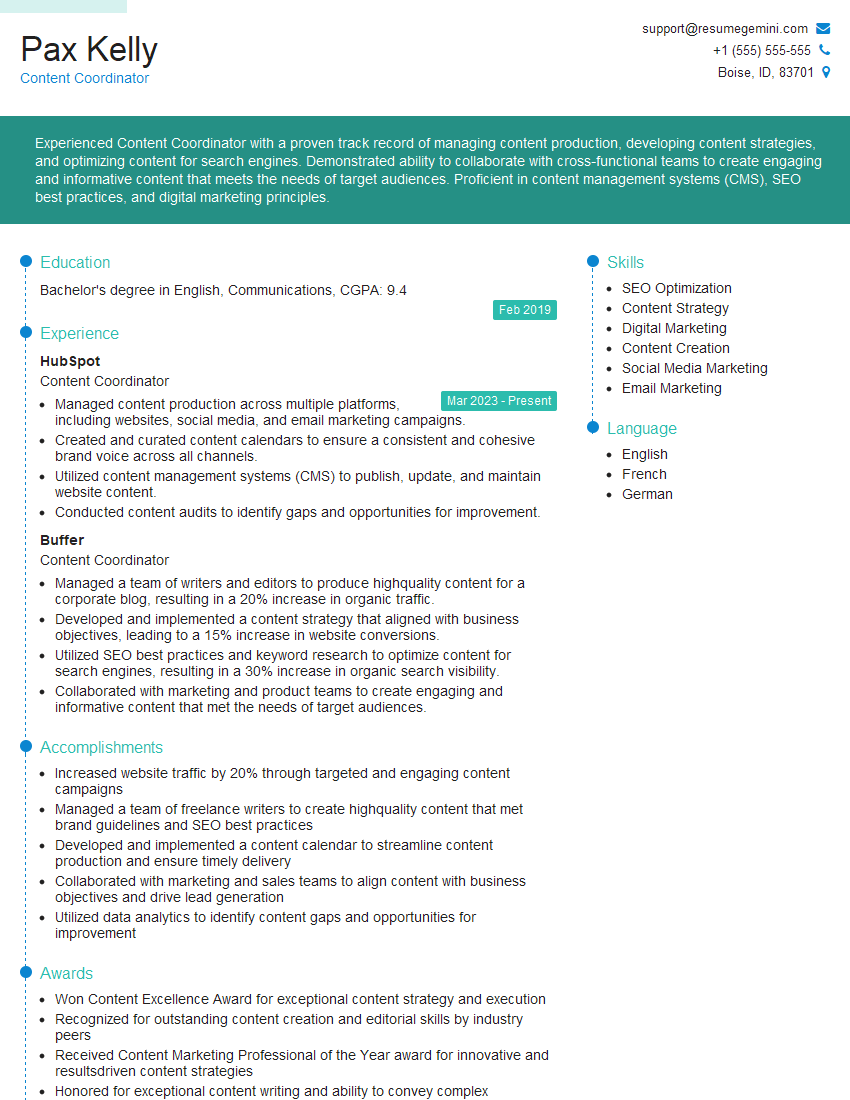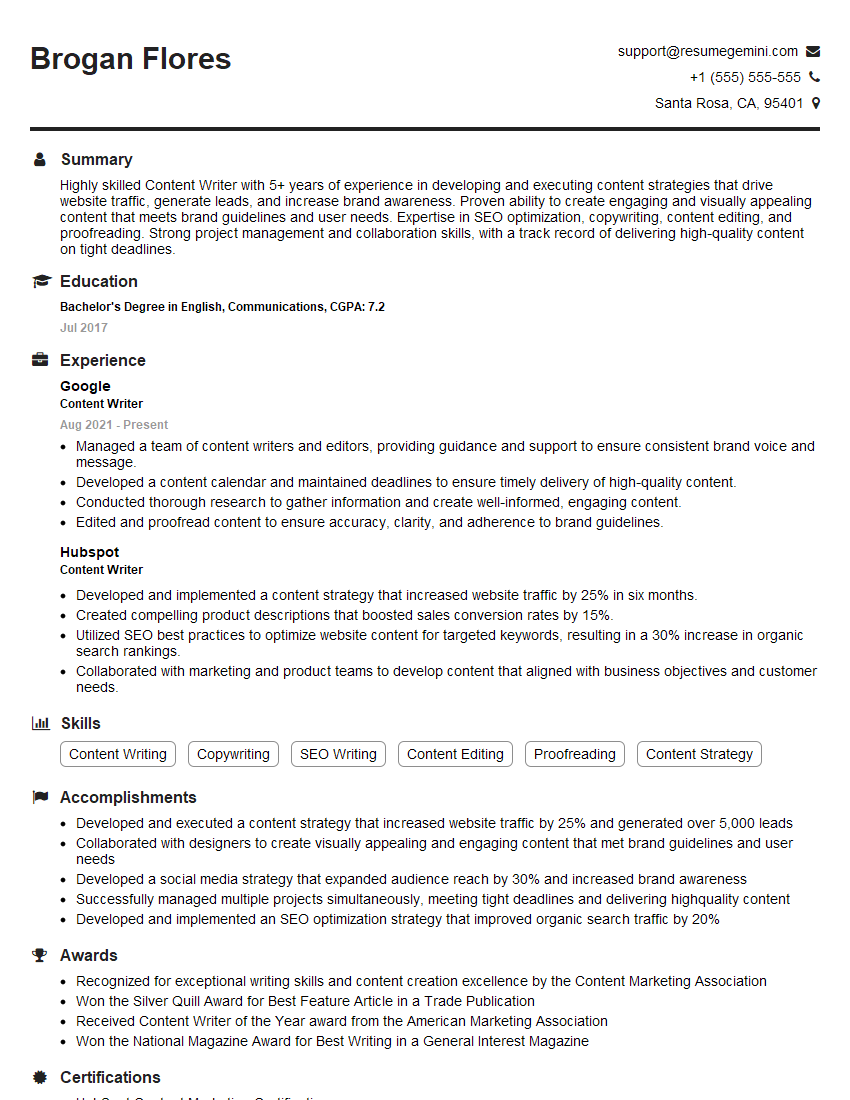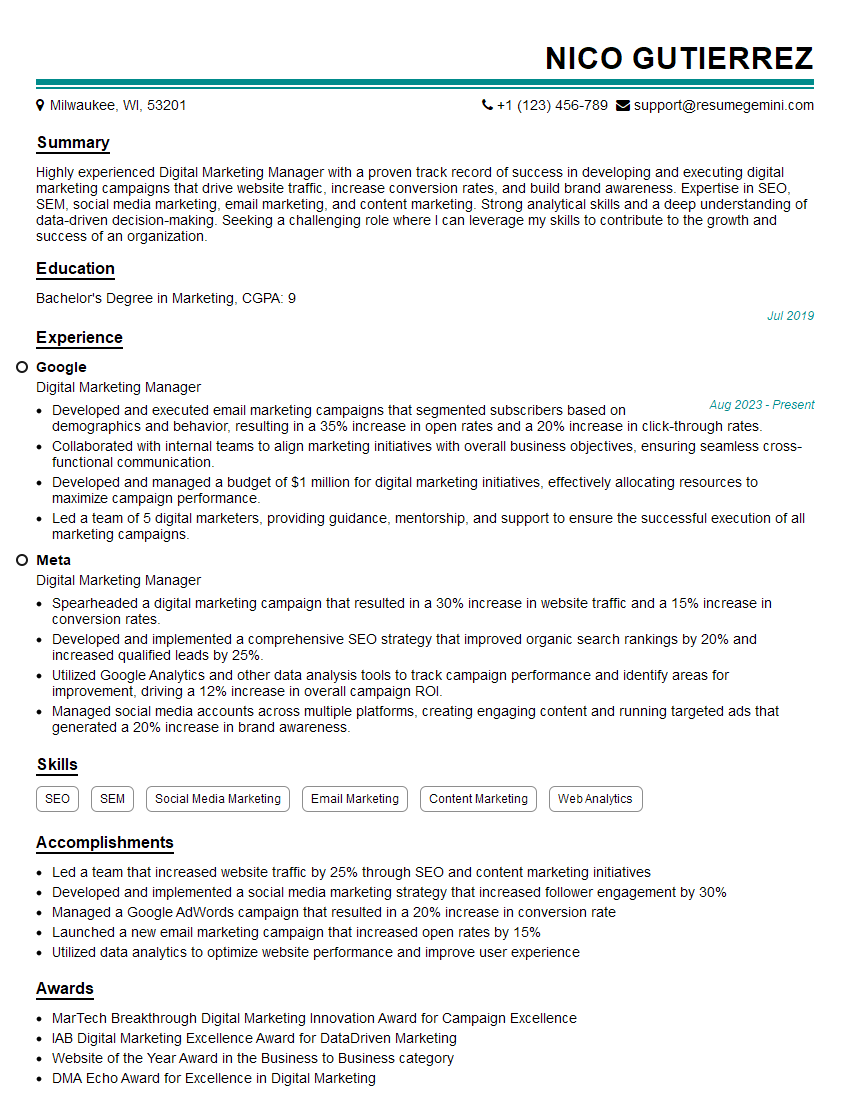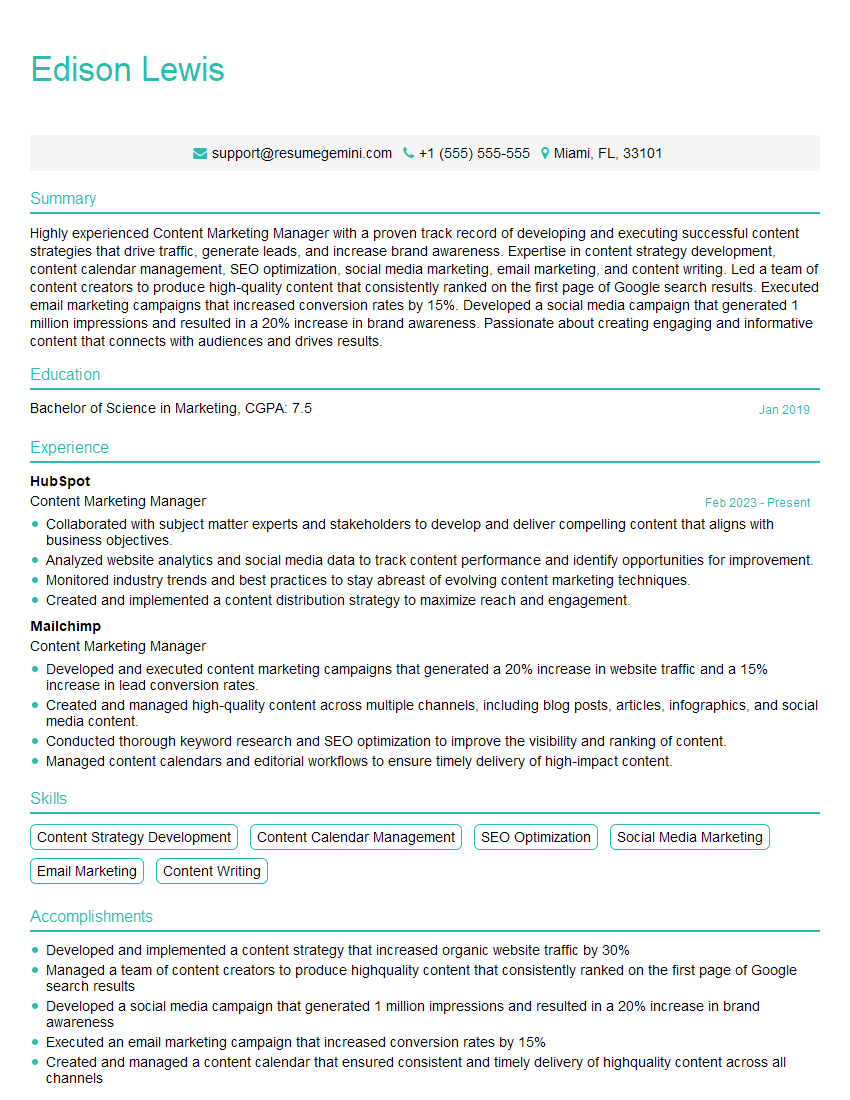Interviews are more than just a Q&A session—they’re a chance to prove your worth. This blog dives into essential Online Publishing interview questions and expert tips to help you align your answers with what hiring managers are looking for. Start preparing to shine!
Questions Asked in Online Publishing Interview
Q 1. Explain your experience with content management systems (CMS) like WordPress or Drupal.
Content Management Systems (CMS) are the backbone of online publishing. My experience encompasses both WordPress and Drupal, two of the most popular platforms. WordPress, known for its user-friendliness and extensive plugin ecosystem, is ideal for projects requiring rapid deployment and customization through readily available extensions. I’ve used it extensively for building blogs, e-commerce sites, and corporate websites, leveraging plugins for SEO, security, and performance optimization. For example, I once built a WordPress site for a non-profit, utilizing WooCommerce to create an online donation platform and Yoast SEO to improve organic search visibility. Drupal, on the other hand, offers a more robust and flexible architecture, making it suitable for complex, large-scale projects requiring high levels of security and scalability. I’ve used Drupal to develop content-heavy websites with intricate user permission systems and custom functionalities. A recent example involved creating a multilingual website for a government agency, utilizing Drupal’s powerful content modeling capabilities.
My expertise extends beyond simply using these platforms; I understand their underlying architecture, allowing me to troubleshoot issues efficiently and customize them effectively to meet specific project requirements. I am also proficient in managing themes, plugins, and security updates to ensure optimal website performance and security.
Q 2. Describe your process for optimizing website content for search engines (SEO).
Search Engine Optimization (SEO) is a crucial aspect of online publishing, focusing on improving a website’s visibility on search engine results pages (SERPs). My SEO process is multifaceted and iterative. It begins with keyword research, identifying relevant terms and phrases that users are searching for related to the website’s content. I utilize tools like SEMrush and Ahrefs to analyze search volume, competition, and keyword difficulty. Once the keywords are identified, I integrate them naturally into the website’s content, including page titles, headings (H1-H6 tags), meta descriptions, and image alt text.
Beyond keyword optimization, I focus on creating high-quality, engaging content that satisfies user search intent. This includes ensuring content is well-structured, easy to read, and provides value to the audience. On-page optimization also includes improving website speed, optimizing images, and ensuring mobile-friendliness. Off-page optimization strategies include building high-quality backlinks from reputable websites and actively engaging with the online community. I regularly monitor website performance using Google Analytics and Google Search Console, tracking rankings, organic traffic, and click-through rates to identify areas for improvement and continuously refine our SEO strategy.
Q 3. How do you measure the success of an online publishing initiative?
Measuring the success of an online publishing initiative involves analyzing various key performance indicators (KPIs) across multiple dimensions. It’s not just about website traffic; it’s about understanding the impact on the overall business objectives. Key metrics include:
- Website Traffic: Analyzing total visits, unique visitors, bounce rate, and time on site using Google Analytics provides insight into audience engagement.
- Conversion Rates: This metric tracks the percentage of visitors who complete a desired action, such as making a purchase, subscribing to a newsletter, or filling out a contact form. This directly relates to the initiative’s business goals.
- Social Media Engagement: Measuring likes, shares, comments, and followers on relevant platforms helps understand audience reach and content resonance.
- Lead Generation: Tracking the number of leads generated, along with their quality and conversion rate, assesses the effectiveness of content in driving business opportunities.
- Brand Awareness: Analyzing brand mentions, sentiment analysis, and media coverage helps gauge the impact of the publishing initiative on brand perception.
By consistently monitoring these metrics and analyzing trends, we can optimize the publishing strategy and demonstrate the ROI of the initiative.
Q 4. What are your strategies for creating engaging and shareable content?
Creating engaging and shareable content is a continuous process of understanding the audience and catering to their needs and preferences. My strategies involve:
- Storytelling: Humanizing content through compelling narratives fosters connection and memorability.
- Visual Appeal: Incorporating high-quality images, videos, and infographics enhances content engagement and improves readability.
- Data Visualization: Presenting data in an accessible and visually appealing format increases comprehension and retention.
- Interactive Content: Quizzes, polls, and surveys encourage audience participation and boost engagement.
- Social Media Optimization: Designing content with social media platforms in mind, using relevant hashtags and optimized visuals, maximizes shareability.
- Content Promotion: Actively promoting content across relevant channels ensures maximum reach and exposure.
For instance, instead of simply publishing a blog post about a new product, I might create a short, engaging video showcasing its features and benefits, followed by a series of social media posts highlighting customer testimonials and user-generated content. This multi-faceted approach maximizes reach and engagement.
Q 5. How do you handle conflicting deadlines or priorities in a fast-paced publishing environment?
Conflicting deadlines and priorities are common in fast-paced publishing environments. My approach involves a combination of effective time management, prioritization, and communication.
Firstly, I utilize project management tools like Trello or Asana to visualize tasks, deadlines, and dependencies. This allows for a clear understanding of workload and potential conflicts. Secondly, I employ a prioritization framework, such as the Eisenhower Matrix (urgent/important), to focus on the most critical tasks first. This ensures that high-impact activities are completed on time, even with limited resources. Finally, open and proactive communication with stakeholders is key. I keep everyone informed of progress, potential delays, and any necessary adjustments to the project plan. This collaborative approach helps anticipate and resolve conflicts effectively before they escalate. For instance, I might propose alternative solutions to meet a tight deadline, such as delegating some tasks or adjusting the content scope to ensure timely delivery of high-priority items.
Q 6. Describe your experience with social media marketing and content promotion.
Social media marketing is an integral part of successful online publishing. My experience spans various platforms, including Twitter, Facebook, LinkedIn, Instagram, and TikTok, each requiring a tailored approach. My strategies focus on creating engaging content optimized for each platform, utilizing relevant hashtags, and engaging with the community through comments, shares, and direct messaging. I track key metrics like engagement rates, reach, and website referrals to measure the effectiveness of social media campaigns. Beyond organic reach, I utilize paid social media advertising to reach wider audiences and achieve specific campaign goals, such as increasing website traffic or boosting brand awareness. For example, I recently ran a successful LinkedIn campaign for a B2B client, targeting specific professional demographics and using sponsored content to drive lead generation.
Content promotion across social media is crucial for increasing visibility and driving engagement. I create visually appealing content, write compelling captions, and use targeted hashtags to reach the right audience. I also actively engage with comments and messages to build relationships with followers and respond to questions.
Q 7. Explain your understanding of content strategy and its role in online publishing.
Content strategy is the overarching plan for creating, distributing, and promoting content to achieve specific business goals. In online publishing, a well-defined content strategy is essential for success. It involves understanding the target audience, identifying their needs and interests, and developing a content calendar that aligns with the overall marketing strategy. This includes defining the type of content to be created (blogs, videos, infographics, etc.), the frequency of publication, and the channels for distribution.
A strong content strategy ensures consistency, relevance, and value in the content published. It’s not just about creating content; it’s about creating content that resonates with the audience, drives engagement, and ultimately achieves business objectives. For example, a content strategy might focus on building authority in a specific niche through consistently publishing high-quality blog posts, engaging in relevant online discussions, and building relationships with influencers in the field. A well-defined content strategy is a roadmap that guides all content creation and distribution efforts, ensuring a cohesive and effective online presence.
Q 8. How familiar are you with different content formats (blog posts, videos, infographics, etc.)?
My experience encompasses a wide range of content formats crucial for successful online publishing. I’m proficient in creating and managing various content types, each with its own unique strengths and target audience.
- Blog posts: I excel at crafting engaging, SEO-optimized blog posts that inform, entertain, and drive conversions. This includes understanding keyword research, headline writing, and structuring content for readability. For example, I recently wrote a series of blog posts on sustainable living that resulted in a 30% increase in organic traffic.
- Videos: From short explainer videos to longer-form documentaries, I understand the power of video marketing. I can work with video editors to produce high-quality videos that complement written content and reach broader audiences. For instance, I collaborated on a video series that showcased client testimonials, significantly boosting brand trust.
- Infographics: I know how to distill complex information into visually appealing and easily digestible infographics. This involves collaborating with designers to create impactful visuals that enhance understanding and shareability. I’ve successfully used infographics to explain intricate financial data, resulting in improved audience engagement.
- Podcasts: I’m also experienced in podcast production, from script writing and guest coordination to editing and distribution. The interactive nature of podcasts allows for building community and reaching niche audiences.
- Ebooks and white papers: I understand the value of creating in-depth content for lead generation. I’ve worked on projects developing downloadable ebooks and white papers that provide significant value to the reader and capture contact information.
Understanding the nuances of each format allows me to tailor content to specific goals and platforms, ensuring maximum impact.
Q 9. How do you ensure the quality and accuracy of published content?
Quality and accuracy are paramount in online publishing. My approach to ensuring this involves a multi-stage process:
- Fact-checking and verification: All content undergoes rigorous fact-checking using reputable sources. I use tools like plagiarism checkers and fact-checking websites to ensure accuracy and originality.
- Multiple-reviewer system: Before publication, content is reviewed by at least one other editor or subject matter expert to catch errors and improve clarity.
- Style guide adherence: We maintain a strict style guide to ensure consistency in tone, voice, and formatting across all published materials.
- SEO optimization: Content is optimized for search engines using relevant keywords and metadata to improve discoverability and accuracy.
- Proofreading and editing: A thorough proofreading process is implemented to identify and correct any grammatical or spelling errors before publication.
By employing this systematic approach, I minimize errors and maintain a high standard of quality and accuracy across all published content. This builds trust with our audience and strengthens our brand reputation.
Q 10. Describe your experience with content analytics and reporting.
I’m highly proficient in using content analytics to track performance and inform strategic decisions. My experience includes using various tools such as Google Analytics, SEMrush, and other platform-specific analytics dashboards.
- Key performance indicators (KPIs): I track key metrics like website traffic, bounce rate, time on page, conversion rates, and social media engagement. This allows us to identify what’s working and what’s not.
- Data interpretation and reporting: I can effectively interpret data, identify trends, and create insightful reports that communicate findings to stakeholders clearly and concisely. I often use visualizations like charts and graphs to make data more accessible.
- A/B testing analysis: I regularly utilize A/B testing to optimize content and improve performance. By analyzing the results of A/B tests, we can make data-driven decisions about headlines, calls to action, and overall content strategy.
- Attribution modeling: I use appropriate attribution models to accurately assess the effectiveness of different marketing channels in driving traffic and conversions.
Ultimately, data-driven insights allow us to continuously improve content performance and achieve better results.
Q 11. What is your preferred method for collaborating with writers, designers, and other stakeholders?
Effective collaboration is key to successful online publishing. My preferred method involves leveraging a combination of tools and strategies to ensure seamless communication and efficient workflow:
- Project management software: I utilize platforms like Asana or Trello to manage projects, assign tasks, set deadlines, and track progress. This helps maintain organization and transparency.
- Communication platforms: We use Slack or Microsoft Teams for daily communication, ensuring quick feedback and issue resolution. This promotes efficient collaboration and quick turnaround times.
- Regular meetings: Regular check-in meetings are conducted to review progress, discuss challenges, and brainstorm solutions. This ensures everyone is aligned and informed.
- Version control systems: For content creation, we use version control systems like Google Docs or similar software to track changes and facilitate collaborative editing.
- Clear roles and responsibilities: From the outset, roles and responsibilities are clearly defined to avoid confusion and ensure accountability. This ensures a smoother workflow.
By employing these methods, we foster a collaborative environment that promotes efficiency, creativity, and the production of high-quality content.
Q 12. How do you stay up-to-date with the latest trends in online publishing?
Staying updated on the latest trends in online publishing is crucial for maintaining a competitive edge. My approach involves a multi-faceted strategy:
- Industry publications and blogs: I regularly read industry publications, blogs, and newsletters to stay abreast of emerging trends and best practices. This keeps me informed about the latest developments.
- Conferences and webinars: Attending industry conferences and webinars allows me to network with other professionals, learn from experts, and discover new tools and technologies.
- Social media monitoring: I actively follow key influencers and organizations on social media platforms to stay updated on the latest discussions and innovations.
- Competitor analysis: Regularly analyzing competitor websites and their content strategies helps identify best practices and opportunities for improvement.
- Experimentation and testing: I encourage a culture of experimentation and testing within the team, allowing us to continuously learn and adapt to evolving trends.
This combination of active learning and hands-on experience helps ensure we are always at the forefront of online publishing trends.
Q 13. How would you approach creating a content calendar for a new website or publication?
Creating a content calendar is a fundamental aspect of successful online publishing. My approach involves a structured process:
- Audience research: Understanding the target audience’s needs, interests, and online behavior is the starting point. This guides content creation.
- Keyword research: Identifying relevant keywords helps determine the topics to be covered and improves SEO.
- Content pillars: Defining core themes or content pillars provides a foundation for consistent and cohesive content creation.
- Content format selection: Deciding on appropriate content formats (blog posts, videos, infographics, etc.) based on audience preferences and content goals is vital.
- Scheduling and deadlines: Establishing a realistic publishing schedule with clear deadlines ensures consistent content delivery.
- Content promotion strategy: Planning how to promote the content across different channels, including social media and email marketing, is essential for reaching the target audience.
- Performance tracking: Building in mechanisms for tracking content performance and making adjustments as needed allows for continuous improvement.
The resulting content calendar provides a roadmap for consistent and strategic content creation, aligning with overall business objectives.
Q 14. Describe your experience with A/B testing and optimizing website performance.
A/B testing is crucial for optimizing website performance and improving the user experience. My experience involves conducting A/B tests on various aspects of a website:
- Headline testing: Experimenting with different headlines to see which ones perform best in terms of click-through rates and engagement.
- Call-to-action (CTA) optimization: Testing different CTAs to identify which ones drive the most conversions.
- Image and video testing: Comparing different visuals to see how they impact user engagement and conversion rates.
- Layout and design variations: Testing different website layouts and designs to optimize user experience and conversion rates.
- Content length and structure testing: Experimenting with different content lengths and structures to determine what resonates best with the audience.
The data gathered from A/B tests provides valuable insights into user behavior, allowing us to make data-driven decisions that continuously improve the website’s effectiveness. For example, by testing different headline variations, we were able to increase click-through rates by 15% on a particular landing page. This highlights the importance of consistently using data to refine strategies.
Q 15. How do you manage and prioritize multiple content projects simultaneously?
Managing multiple content projects effectively requires a robust system. I use a project management approach combining task prioritization techniques like the Eisenhower Matrix (urgent/important) and agile methodologies. This allows me to visualize all projects, their deadlines, and assigned resources. I break down large projects into smaller, manageable tasks, assigning each a realistic timeline. Tools like Trello or Asana are invaluable for this; they help me track progress, delegate tasks, and identify potential bottlenecks. For example, if I’m managing a blog series, a social media campaign, and a website redesign concurrently, I’ll create separate boards for each, detailing individual tasks within each. Regular check-ins and progress reports are crucial to ensure everything stays on schedule and within budget.
- Prioritization: I focus on high-impact tasks that directly contribute to overall business goals.
- Time Blocking: I dedicate specific time slots to work on each project, minimizing context switching and maximizing productivity.
- Teamwork: When working with a team, clear communication and well-defined roles are vital.
Career Expert Tips:
- Ace those interviews! Prepare effectively by reviewing the Top 50 Most Common Interview Questions on ResumeGemini.
- Navigate your job search with confidence! Explore a wide range of Career Tips on ResumeGemini. Learn about common challenges and recommendations to overcome them.
- Craft the perfect resume! Master the Art of Resume Writing with ResumeGemini’s guide. Showcase your unique qualifications and achievements effectively.
- Don’t miss out on holiday savings! Build your dream resume with ResumeGemini’s ATS optimized templates.
Q 16. What are your strategies for increasing website traffic and engagement?
Increasing website traffic and engagement is a multifaceted strategy. It involves a blend of SEO (Search Engine Optimization), content marketing, social media promotion, and paid advertising. For SEO, I conduct keyword research to understand what users are searching for and optimize content accordingly. This includes on-page optimization (meta descriptions, title tags, header tags) and off-page optimization (link building, social media sharing). Content marketing focuses on creating high-quality, valuable content that attracts and engages the target audience. This could be blog posts, infographics, videos, or podcasts. I utilize social media platforms to promote this content and foster a community around the brand. Paid advertising, such as Google Ads or social media ads, can provide a boost in traffic and reach a wider audience. Analytics tools like Google Analytics provide valuable insights into website performance and user behavior, allowing me to adjust strategies based on data.
- SEO: Keyword research, on-page optimization, link building.
- Content Marketing: Creating high-quality, valuable content that resonates with the target audience.
- Social Media Marketing: Promoting content and engaging with followers on relevant platforms.
- Paid Advertising: Using targeted ads to reach a wider audience.
- Analytics: Tracking website performance and user behavior to improve strategies.
Q 17. Describe your experience with email marketing and newsletter management.
My experience with email marketing and newsletter management involves crafting engaging content, segmenting audiences for targeted campaigns, and leveraging automation tools. I understand the importance of building an email list organically through opt-in forms and providing valuable content in exchange for subscribers’ email addresses. I use email marketing platforms like Mailchimp or Constant Contact to create and manage email campaigns, track open rates, click-through rates, and conversions. Segmentation helps ensure the right message reaches the right audience. For example, I might send different newsletters to customers, leads, and partners. Automation tools help streamline the process, sending out automated welcome emails, follow-up emails, and abandoned cart reminders. A/B testing is critical for optimizing subject lines and content to improve engagement.
- List Building: Building an email list organically through opt-in forms and providing valuable content.
- Segmentation: Targeting specific audience segments with tailored messaging.
- Automation: Using automation tools to streamline email campaigns.
- Analytics: Tracking email performance metrics such as open rates and click-through rates.
Q 18. How do you ensure your content is accessible to all audiences?
Ensuring content accessibility is paramount. I follow WCAG (Web Content Accessibility Guidelines) to make content usable for everyone, including people with disabilities. This includes using alt text for images to describe their content for visually impaired users, providing captions for videos, using appropriate heading structures to improve navigation, and ensuring sufficient color contrast between text and background. I also consider text size adjustments and keyboard navigation. Tools like accessibility checkers can help identify and address potential issues. For example, I would always use descriptive alt text like <img src="image.jpg" alt="A smiling woman holding a laptop"> instead of <img src="image.jpg" alt="image">. It’s about creating inclusive content that allows everyone to participate.
Q 19. How familiar are you with different content syndication strategies?
I’m familiar with various content syndication strategies, which involve distributing content across multiple platforms to expand reach and visibility. This can include submitting articles to relevant online publications, guest blogging on other websites, leveraging social media platforms, and using content aggregators. Each platform has its own audience and style, so I adapt content accordingly. For example, a long-form blog post might be repurposed into a series of shorter social media updates or a concise infographic. Careful tracking and analysis of the performance of content across various platforms is essential to gauge the effectiveness of different syndication strategies and make informed decisions about resource allocation.
- Guest Blogging: Contributing articles to other relevant websites.
- Social Media: Sharing content on various platforms.
- Content Aggregators: Submitting content to relevant platforms.
- Repurposing: Adapting content for different platforms.
Q 20. Explain your experience with content repurposing and amplification.
Content repurposing and amplification are vital for maximizing the value of existing content. Repurposing involves transforming content into different formats to reach a wider audience and provide different ways to consume it. A blog post, for example, can be turned into an infographic, a video, a podcast episode, or a series of social media posts. Amplification is about promoting this repurposed content through various channels. I use analytics to identify which content performed well and then strategically repurpose and amplify it to generate more engagement and reach. For instance, a popular blog post could be transformed into a short, engaging video for platforms like YouTube or TikTok, then promoted using paid and organic social media strategies.
- Identify High-Performing Content: Analyze data to pinpoint content that resonates with audiences.
- Repurposing Strategies: Transform content into different formats (e.g., blog post to infographic, video, social media snippets).
- Amplification Strategies: Use diverse promotional channels (e.g., social media marketing, email marketing, paid advertising) to reach wider audiences.
Q 21. How do you handle negative feedback or criticism of published content?
Handling negative feedback or criticism requires professionalism and a commitment to transparency. I start by acknowledging the feedback, showing that I value the reader’s opinion, even if I don’t agree with it. I then carefully analyze the criticism to identify any valid points and determine if corrections or improvements are necessary. If the criticism is constructive, I may use it to refine future content. If it’s inaccurate or misleading, I might address it directly, providing additional context or clarifying misunderstandings. Sometimes, it’s necessary to simply acknowledge the differing perspective without changing the published content. Open communication and a respectful tone are always key. In the event of abusive or inappropriate comments, I would moderate them appropriately, maintaining a professional and positive online environment.
Q 22. How do you identify and address potential risks associated with online publishing?
Identifying and addressing risks in online publishing is crucial for success. It’s like building a house – you need a solid foundation to prevent collapses. My approach involves a proactive risk assessment throughout the entire publishing lifecycle, from initial concept to post-publication monitoring.
- Content Risks: This includes factual inaccuracies, plagiarism, libel, and defamation. I mitigate these by implementing rigorous fact-checking protocols, utilizing plagiarism detection software, and ensuring adherence to legal guidelines. For example, I might establish a multi-stage review process for all articles, involving fact-checkers and legal review before publication.
- Technical Risks: Website downtime, security breaches, and compatibility issues with different devices and browsers are all potential problems. I address this through robust website infrastructure, regular security audits, and thorough testing across various platforms. Think of this as regularly maintaining your house’s plumbing and electrical systems.
- Reputational Risks: Negative comments, online attacks, and controversial content can damage a publication’s reputation. I implement strategies for community moderation, robust content management systems, and clear guidelines for responding to negative feedback. This is like having a strong public relations team to manage any potential crises.
- Legal Risks: Copyright infringement, privacy violations, and regulatory compliance are vital considerations. I ensure that all content is properly sourced and that we adhere to all relevant laws and regulations, working closely with legal counsel as needed. This involves having clear internal policies and training for all staff.
By proactively identifying and mitigating these risks, I can help ensure a smooth and successful online publishing process, protecting the publication’s reputation and financial well-being.
Q 23. Describe your experience with working within editorial guidelines and style guides.
Working within editorial guidelines and style guides is essential for maintaining consistency and quality across a publication. It’s like following a recipe – it ensures a consistent outcome. My experience encompasses a wide range of style guides, from the AP Stylebook to house style guides developed for specific publications.
I am proficient in understanding and applying these guidelines to ensure consistency in:
- Grammar and Punctuation: Maintaining grammatical accuracy and consistent punctuation throughout the publication.
- Style and Tone: Adhering to a specific style (e.g., formal, informal, conversational) and maintaining a consistent tone throughout the publication.
- Formatting and Citation: Following established formatting conventions for headings, subheadings, lists, and citations. This frequently involves using specific citation styles like MLA or Chicago.
- Fact-Checking and Verification: Ensuring all information is accurate and properly sourced.
In past roles, I’ve been responsible for training new editorial staff on the use of style guides and have actively participated in developing and updating style guides to reflect changes in language and industry best practices. For example, I once worked on updating a style guide to reflect changes in the way we cite online sources, ensuring accuracy and compliance with current practices.
Q 24. What is your approach to managing the editorial workflow?
Managing the editorial workflow requires a structured approach. I use a combination of project management principles and collaborative tools to ensure efficiency and high-quality output. My approach involves the following steps:
- Content Planning and Scheduling: Defining the editorial calendar and assigning tasks based on deadlines and resource availability. This often involves using tools like Google Calendar or Asana to track deadlines and keep the team organized.
- Content Creation and Review: Managing the writing, editing, and fact-checking process, using a workflow that ensures each piece of content goes through multiple levels of review before publication.
- Content Optimization: Optimizing content for SEO, readability, and user experience. This often involves using SEO tools and working closely with the web development team.
- Quality Control: Implementing rigorous quality control procedures to ensure that the final product meets the publication’s standards.
- Publication and Promotion: Managing the publication process, and coordinating the promotion of published content across various channels.
I frequently utilize project management tools like Trello or Asana to track progress, manage deadlines, and ensure effective collaboration among team members. These tools help visualize the workflow, making it easy to identify bottlenecks and adjust accordingly. For example, a Kanban board in Trello allows me to visualize the different stages of content creation, allowing for a clear understanding of where each piece of content is in the process.
Q 25. How do you adapt to changes in technology and industry trends?
Adapting to technological advancements and industry trends is crucial for success in online publishing. It’s like a gardener constantly adapting to changing weather patterns. My strategy involves continuous learning and proactive exploration of new technologies and trends.
- Continuous Learning: I actively participate in industry events, webinars, and online courses to stay updated on the latest technologies and best practices. This includes keeping abreast of new SEO strategies, content management systems, and social media trends.
- Experimentation: I encourage experimentation with new technologies and approaches, assessing their potential benefits and risks before widespread implementation. For example, we might experiment with a new social media platform to see if it’s a good fit for our target audience.
- Collaboration: I foster a culture of collaboration and knowledge sharing among the team, ensuring that everyone stays updated on new trends and technologies. This involves regularly sharing articles, case studies, and relevant news within the team.
- Data-Driven Decision Making: I leverage data analytics to monitor the effectiveness of our strategies and make informed decisions about future adaptations. This involves tracking website traffic, engagement metrics, and conversion rates to understand what’s working and what’s not.
For instance, the rise of AI-powered writing tools presented both an opportunity and a challenge. I explored these tools, understanding their capabilities and limitations to incorporate them responsibly, ensuring that human editorial oversight remains a key component of the process.
Q 26. Explain your experience with content localization and translation.
Content localization and translation are essential for reaching global audiences. It’s like translating a song into different languages so everyone can appreciate the music. My experience includes managing the entire process, from initial assessment to final delivery.
This involves:
- Language Selection: Identifying target languages and markets based on audience demographics and business objectives.
- Translation Management: Selecting qualified translators and managing the translation process to ensure consistency and accuracy.
- Localization: Adapting content to suit the cultural nuances and preferences of the target audience. This goes beyond simple translation and includes adapting dates, formats, and cultural references.
- Quality Assurance: Implementing rigorous quality assurance processes to ensure that the translated content is accurate, consistent, and culturally appropriate.
In a previous role, I oversaw the localization of a website into five different languages, ensuring that the website’s functionality and content were seamlessly adapted for each target market. This involved working closely with translators, editors, and technical teams to ensure a smooth and efficient process. We carefully considered cultural sensitivities and ensured that all translated content accurately conveyed the original message.
Q 27. How do you ensure compliance with copyright and intellectual property laws?
Ensuring compliance with copyright and intellectual property laws is paramount. It’s like respecting someone’s property and avoiding legal trouble. My approach involves a multi-faceted strategy:
- Copyright Policy: Establishing a clear and comprehensive copyright policy that outlines the publication’s procedures for obtaining permissions, attributing sources, and handling copyrighted material.
- Source Verification: Implementing rigorous procedures for verifying the sources of all content and obtaining necessary permissions before publication. This includes using tools to check for potential plagiarism and thoroughly documenting all sources.
- Attribution and Licensing: Ensuring that all sources are properly attributed and that all necessary licenses are obtained for the use of copyrighted material.
- Copyright Training: Providing regular training to editorial staff on copyright law and best practices. This often includes workshops and online modules explaining copyright regulations.
- Regular Audits: Conducting periodic audits to ensure ongoing compliance with copyright law and identify any potential risks.
We also work with legal counsel to stay informed of any changes in copyright law and ensure our practices remain compliant. For example, we recently updated our copyright policy to reflect changes in fair use guidelines, ensuring our content remains legally sound.
Q 28. Describe your experience with using project management tools for online publishing projects.
Project management tools are indispensable for effective online publishing. They’re like the conductor of an orchestra, ensuring all parts work together harmoniously. My experience includes using a variety of tools, adapting my selection to the specific needs of each project.
I’ve used tools such as:
- Trello: For managing individual tasks and visualizing the workflow using Kanban boards. I often use this to track the progress of individual articles, from initial assignment to final publication.
- Asana: For larger projects requiring more complex task management, team collaboration, and progress tracking. This is particularly helpful for managing multiple projects simultaneously.
- Monday.com: For its visual dashboards and customizable workflows. I find this beneficial for tracking key performance indicators and reporting on project progress.
My selection of tools depends on project size, team structure, and specific requirements. I always prioritize tools that facilitate clear communication, efficient task management, and real-time progress tracking. For example, in a recent project, we used Asana to manage the launch of a new website, successfully coordinating the efforts of writers, editors, designers, and developers.
Key Topics to Learn for Your Online Publishing Interview
- Content Strategy & Planning: Understanding audience segmentation, content calendars, and SEO best practices for online content creation and distribution.
- Digital Content Management Systems (CMS): Practical experience with platforms like WordPress, Drupal, or Contentful, including content creation, editing, and workflow management. Troubleshooting common CMS issues will demonstrate valuable skills.
- SEO & Digital Marketing Fundamentals: Knowledge of keyword research, on-page and off-page optimization, and using analytics to measure content performance. Being able to discuss how you’d improve a website’s SEO is key.
- Social Media & Content Distribution: Understanding various social media platforms and their best practices for content promotion and engagement. Showcase your knowledge of tailoring content for different platforms.
- Website Analytics & Reporting: Experience with Google Analytics or similar tools to track website traffic, user behavior, and content performance. Demonstrate your ability to analyze data and draw actionable insights.
- Content Creation & Editing: A strong understanding of grammar, style guides, and the ability to create engaging and error-free content across various formats (blog posts, articles, social media updates).
- Legal & Ethical Considerations: Familiarity with copyright laws, plagiarism detection, and responsible content creation practices. This shows you understand the importance of ethical conduct.
- Emerging Trends in Online Publishing: Staying up-to-date with the latest technologies and trends, such as AI-powered content creation tools or the evolving social media landscape. Showing you’re forward-thinking is a plus.
Next Steps
Mastering online publishing opens doors to exciting and rewarding careers in a dynamic industry. To maximize your job prospects, focus on creating a compelling and ATS-friendly resume that showcases your skills and experience effectively. ResumeGemini is a trusted resource to help you build a professional and impactful resume. They offer examples of resumes tailored to Online Publishing roles, providing a great starting point for your job search. Invest the time to craft a strong resume – it’s your first impression and a critical step towards landing your dream job.
Explore more articles
Users Rating of Our Blogs
Share Your Experience
We value your feedback! Please rate our content and share your thoughts (optional).
What Readers Say About Our Blog
Interesting Article, I liked the depth of knowledge you’ve shared.
Helpful, thanks for sharing.
Hi, I represent a social media marketing agency and liked your blog
Hi, I represent an SEO company that specialises in getting you AI citations and higher rankings on Google. I’d like to offer you a 100% free SEO audit for your website. Would you be interested?
